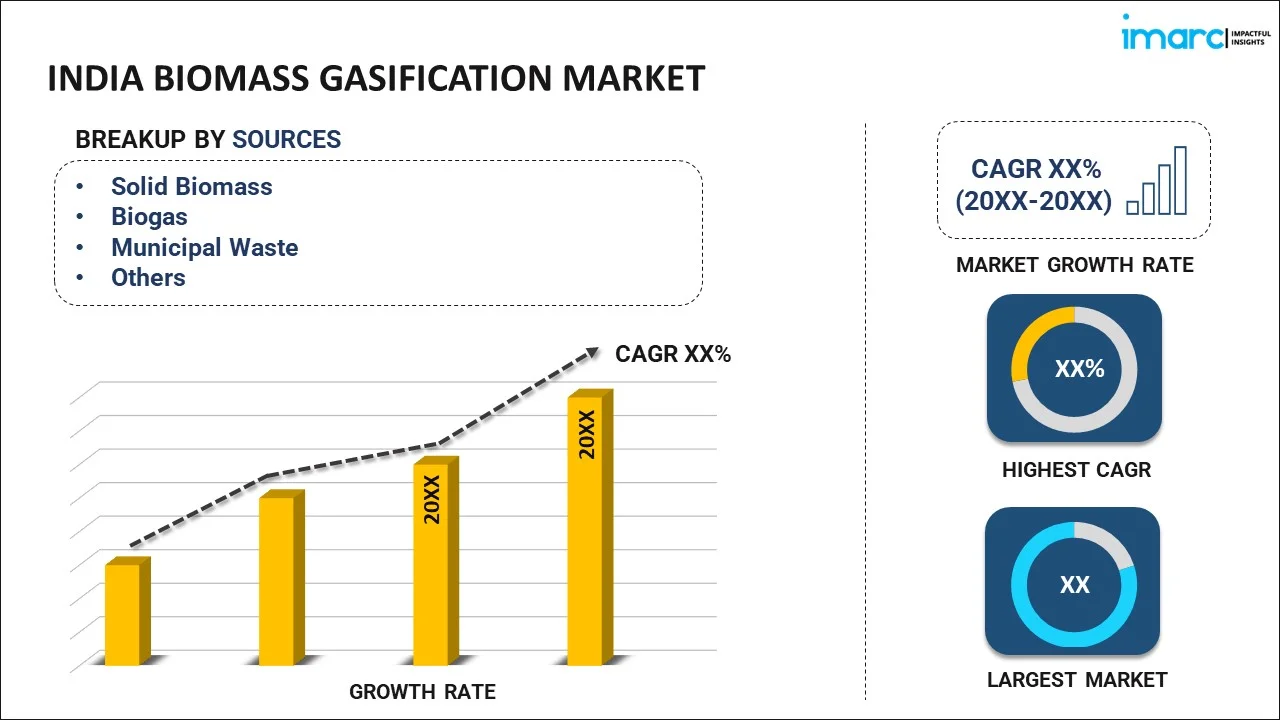
India Biomass Gasification Market Report by Source (Solid Biomass, Biogas, Municipal Waste, Liquid Biomass), and Region 2025-2033
Market Overview:
The India biomass gasification market size reached 24.0 TWh in 2024. Looking forward, IMARC Group expects the market to reach 32.0 TWh by 2033, exhibiting a growth rate (CAGR) of 3.07% during 2025-2033.
|
Report Attribute
|
Key Statistics
|
|---|---|
|
Base Year
|
2024
|
|
Forecast Years
|
2025-2033
|
|
Historical Years
|
2019-2024
|
|
Market Size in 2024
|
24.0 TWh |
|
Market Forecast in 2033
|
32.0 TWh |
| Market Growth Rate 2025-2033 | 3.07% |
Biomass gasification refers to the process involving the thermo-chemical conversion of biomass into a combustible gas mixture, including hydrogen and carbon monoxide (CO). It consists of a gasifier system that contains a reactor where the gases are generated. The energy produced is further utilized to generate power for electricity and transportation. Biomass gasification is generally adopted to meet the thermal and electrical needs of various industries. Due to the rising environmental concerns among the masses, biomass gasification is widely utilized as a preferred substitute for conventional fuels, such as diesel, coal and furnace oils.
The market in India is primarily driven by the increasing demand for rural electrification. This is supported by the numerous initiatives undertaken by public and private agencies to provide electricity in rural areas across India. For instance, the Decentralized Energy Systems of India (DESI Power), a non-profit organization, is investing in the installation of biomass gasification mini-grid systems that are expected to provide electricity and job opportunities to individuals living in rural areas. Along with this, the increasing investments by the Government of India (GoI) in the development of multifaceted biomass gasifier-based power plants that produce electricity with the help of locally available natural resources, including wood chips and cotton stalks, and agro-residues, are further creating a positive outlook for the market. Some of the other factors contributing to the market growth include rapid industrialization and extensive research and development (R&D) activities conducted by key players to introduce hybrid solar-biomass gasification systems that aim to improve reliability while reducing the overall cost.
Key Market Segmentation:
IMARC Group provides an analysis of the key trends in each segment of the India biomass gasification market report, along with forecasts at the country and regional levels from 2025-2033. Our report has categorized the market based on source.
Breakup by Source:

- Solid Biomass
- Biogas
- Municipal Waste
- Liquid Biomass
Breakup by Region:
- North India
- West and Central India
- South India
- East India
Competitive Landscape:
The competitive landscape of the industry has also been examined along with the profiles of the key players.
Report Coverage:
| Report Features | Details |
|---|---|
| Base Year of the Analysis | 2024 |
| Historical Period | 2019-2024 |
| Forecast Period | 2025-2033 |
| Units | TWh |
| Segment Coverage | Source, Region |
| Region Covered | North India, West and Central India, South India, East India |
| Customization Scope | 10% Free Customization |
| Post-Sale Analyst Support | 10-12 Weeks |
| Delivery Format | PDF and Excel through Email (We can also provide the editable version of the report in PPT/Word format on special request) |
Key Questions Answered in This Report:
- How has the India biomass gasification market performed so far and how will it perform in the coming years?
- What has been the impact of COVID-19 on the India biomass gasification market?
- What are the key regional markets?
- What is the breakup of the market based on the source?
- What are the various stages in the value chain of the industry?
- What are the key driving factors and challenges in the industry?
- What is the structure of the India biomass gasification market and who are the key players?
- What is the degree of competition in the industry?
Need more help?
- Speak to our experienced analysts for insights on the current market scenarios.
- Include additional segments and countries to customize the report as per your requirement.
- Gain an unparalleled competitive advantage in your domain by understanding how to utilize the report and positively impacting your operations and revenue.
- For further assistance, please connect with our analysts.
 Inquire Before Buying
Inquire Before Buying
 Speak to an Analyst
Speak to an Analyst
 Request Brochure
Request Brochure
 Request Customization
Request Customization




.webp)




.webp)












